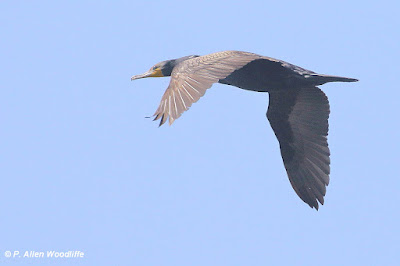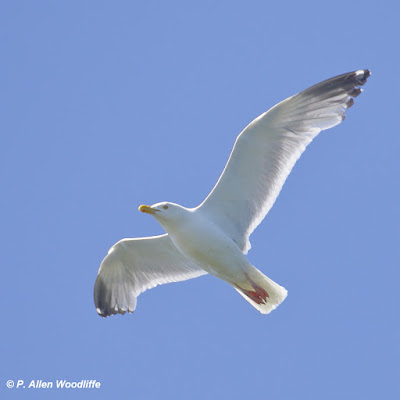Earlier this week, I finally got around to doing something that I had planned to do for quite awhile. Procrastinating, for whatever reasons, is a human trait, I suppose. I won't bore you with the various reasons I was unable to or did not get out. At any rate, after about a 5-year hiatus, I got my kayak out and explored an area I had had my eye on for quite some time. It was the mosaic of cattail and phragmites islands out in Lake St. Clair, a bit southwest of the village of Mitchell's Bay.
Mitchell's Bay is immediately north of this image. The complex of islands at the left hand side of this photo are just about a kilometre or so off shore and have always intrigued me. Anytime I scan them with binoculars or 'scope from the end of Angler Line, more or less where Waterway Camp is shown on the above photo, it seems there is a lot of bird activity going on out there: herons, egrets, gulls, cormorants, etc, etc. Is there a heronry there, and is that where a Cattle Egret has nested in the past? One or more has shown up on the mainland sometimes over a period of several weeks, in years gone by. And what happened to the colony of Yellow-headed Blackbirds that used to nest in the wetland right along Angler Line? They are still around somewhere.
Time to find out.
This past Monday looked like ideal conditions for venturing out: moderate temperatures, light NE winds so this side of the lake would be quite calm (I'm not a white water kayaker, especially with expensive camera gear!) and sunny skies. Off I went. I would suggest that the little islands are more abundant and a bit larger now, I believe, than during the higher water levels when this aerial photo was taken. So there was more to explore. There was a constant streaming of water birds in view, as usual. Even while I was on my out, I could see an occasional one or two Yellow-headed Blackbirds heading for the mainland, so I went in the direction they seemed to be coming from. And bingo....it was only the second patch of vegetation I got to where I heard, and then saw this sought after species.
They seemed to be fairly unconcerned about my approach, and I have often found that boats and kayaks are much more tolerated by wildlife than if I was walking by. So I paddled closer, and this is one of the first photos I got, just in case they got nervous and wouldn't let me get any closer. It is the equivalent of about 13X.
Not to worry, however. The males were busy giving their distinctive, raucous calls, and it appeared they were clearly more concerned about neighbouring males than my bright yellow kayak floating below.I carefully paddled closer, taking advantage of the light wind propelling me a bit, and also managed a bit of directional control with my rudder. I eventually got so close that with my other lens, I probably couldn't even focus! At any rate, one or two of the males were right at the edge of the phragmites, and quite nicely displayed.
From time to time one of the females would be visible, shown below, but most of the time I expect they were busy tending to a nearby nest with eggs or young. I estimated I saw at least 20 of these birds, and the vast majority of them were males. There could easily have been twice as many. It was certainly a delight to finally get up close to where this more westerly bird species was nesting.
While I was approaching the Yellow-headed Blackbirds, I heard a Common Gallinule calling. Following the sound, I noted that one adult was at the very edge of the vegetated island, and seemed intent on something a little farther along that edge.
And here is what the adult was focussing on. A fourth bird was just out of the field of view.Perhaps the adult was warning the young about an approaching big yellow thing, and tried to get the youngsters to get back into the vegetation. But not being fluent in gallinule-speak, I can only guess. At any rate, it didn't take long for the youthful gallinules to disappear into the vegetation, although I could track them to some extent by hearing the constant chatter of this family.
I continued on. There was no shortage of birds to aim my camera at. Mute Swans, not surprisingly, were abundant. What was surprising was how intolerant of me and my kayak they were. Even though there were probably at least 100 birds scattered about, some with families of cygnets to look after, most of them took flight even while I was well away from them. Perhaps they have had experience with boats approaching aggressively. As photogenic as they are, this non-native species is a real menace to native waterfowl. One or two would stick around, enabling me to get this almost full frame photo.
Gulls were not plentiful. Once in awhile a Herring Gull would fly nearby, but there was no sign of any of them nesting at this island complex.
There was even an occasional Common Grackle....
....and of course a few Red-winged Blackbirds.
I noted a fair number of Black-crowned Night-Herons in the area, and along with even more Great Egrets, seemed to be coming and going to one of the larger islands.
I paddled closer, and found a way to get at least partially into the island. The water was calm, and I sat here for awhile, watching the herons and egrets come and go. This next photo was taken with a very wide angle lens. A closer look will show a couple of white birds in the blue sky. These were Great Egrets flying around, and were actually much closer than the wide angle lens would suggest.
There was even an occasional Green Heron and Least Bittern flying around the
area. It seemed like there were at least two heronries, based on where
the herons and egrets were coming from and going to. Add to that, there
was quite a cacophony of sound, made both by the adults but even more so
by the young in the nest that were clamouring for food. The thick phragmites and cattail vegetation made it impossible to see what was going on, or how many nests there might be. If I only had a drone......
A smaller island had some of the phragmites dead and knocked down providing quite a bit of potential nesting habitat for another more western species. I noted quite a few Forster's Terns flying about, with some setting in the downed mat of phragmites, so I went to investigate.
Some individuals were missing their long streamer tails.There were several that seemed to be setting on a nest, and only got up and left when I got too close. I couldn't get close enough to see over the dead vegetation and find out whether they were setting on eggs or young.
Clearly some were exhibiting an aerial defense, and dive-bombed me frequently and at relatively close range.
Others were busy bringing food, either to a mate or to the young.
All in all, it was a very fun outing, and certainly well worth the effort. I am so glad I didn't let more time slip by before exploring this wetland complex. I didn't see any evidence of a Cattle Egret, although I never could see right into the heronry due to the height and density of the vegetation. Maybe next time.
A few years ago, I wrote a piece in OFO News, the newsletter of the Ontario Field Ornithologists, about the usefulness of a kayak in birding. Check it out at this link.If you would like to subscribe, or unsubscribe, to Nature Nuggets, send an email to: prairietramper@gmail.com






















Now that must have been interesting to explore!
ReplyDeleteWhat an exciting endeavor! The peace from humans and the delightful cacophony from the birds. I'm sure you won't wait so long before another visit.
ReplyDeleteIt was indeed an exciting time. Being out on the peaceful water setting, as I'm sure you know from your own experience, is always worth the effort. I do hope to get out there, or somewhere similar, again and soon!
Delete